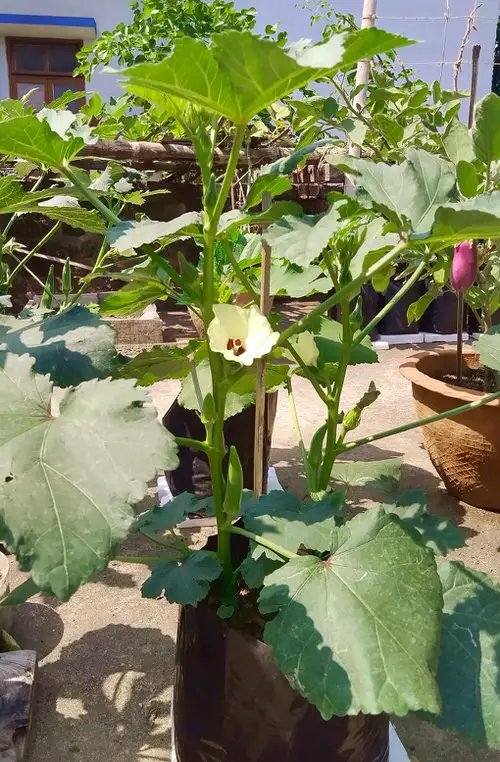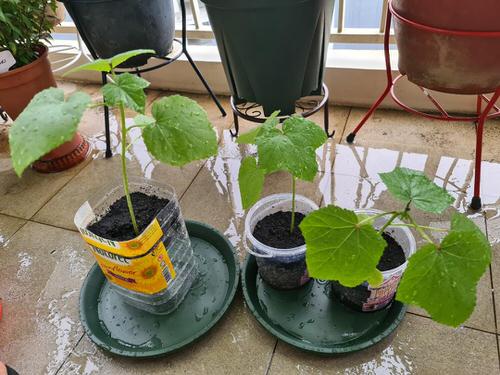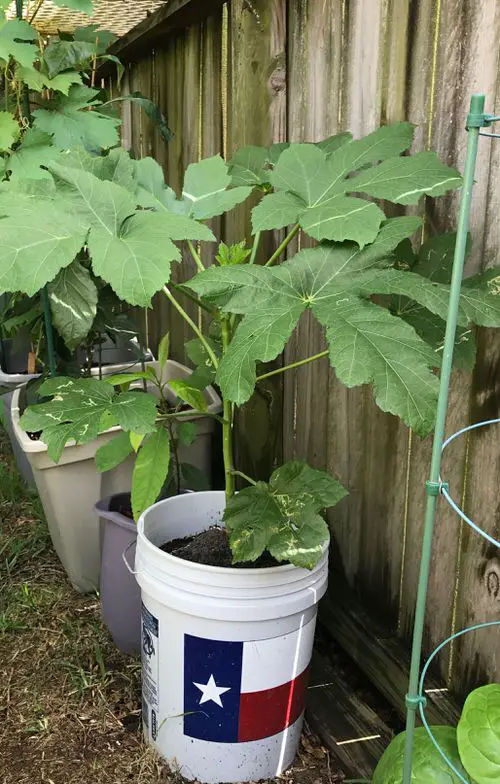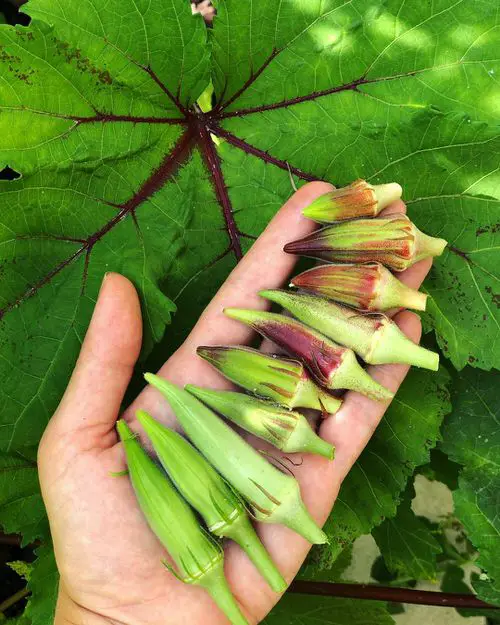If you know How To Grow Okra In Containers, then harvesting it most of the year is an easy task! Let’s learn all about Growing Okra In Pots!

Okra, also called lady’s finger, is a warm-season tropical vegetable with a unique, earthy taste like no other vegetable. Its delicate foliage and showy blooms look like hibiscus, making it a great ornamental plant as well! If you want to add it to your kitchen garden, then here’s all the information on Growing Okra In Pots!
Check out the best summer vegetables to grow in pots here
Choosing a Pot for Growing Okra 
For growing okra–choose a pot that is at least 10-12 inches wide and deep. You can go for any material you like. It is best to select a black-colored pot if you live in a cold climate, as okra loves heat, and the color black absorbs it.
Planting Okra Seeds

The first step in growing okra is to get the seeds. You can grow any okra variety in a pot, but it is best if you choose the dwarf one. If you live in a climate with short summers, search for varieties that mature fast.
The best okra planting time is when the temperature starts to stay above 55-60 F (13-16 C) after all the dangers of frost have passed. Growing okra is possible year-round if you live in USDA Zones 9-11 or other subtropical or tropical regions.
Due to its long taproot, okra doesn’t transplant well. You’ll have to directly plant the seeds in the container or get a biodegradable pot. Sow 2-3 okra seeds 1/2 to 1 inch deep in each pot. Water with a sprayer and keep the seeds in a bright, warm place. The substrate should remain moist until the seeds germinate.
The germination takes 5 to 14 days after sowing.
Learn how to start a balcony kitchen garden here
Best Okra Varieties to Grow in Pots
Baby Bubba Hybrid, Cajun Delight, Blondy, Perkins Long Pod, Silver Queen, Clemson Spineless, and Star of David are the best ones you can grow for a plentiful harvest.
Requirements for Growing Okra in Pots

Position
Pick a spot that receives full sun (at least 5-6 hours of sunlight is essential). Like tomatoes and peppers, okra requires plenty of sunlight to produce well.
Soil
The soil you use must be loamy, crumbly, and well-draining. Opt for a soilless potting mix rich in organic matter. You can also add plenty of compost or aged cow manure to provide a constant supply of nutrients to your okra plant.
Watering
Okra requires slightly moist soil all the time to grow best. Water regularly to keep the soil uniformly wet and particularly more from the beginning of the flowering period until production. Do make sure that the growing medium is never going to dry completely.
Temperature
The cultivation of the okra plant is extremely easy but requires warmth. The plant can grow above 50 F (10 C), but to flower and bear fruit abundantly, the temperature must be around 70 to 95 F (21-35 C) ideally.
It can tolerate higher temperatures well but fails to grow when the temperature starts to touch lower levels.
Find out the best container vegetables to grow here
Okra Plant Care

Fertilization
Mix manure in the soil to provide additional nutrients. You can also side-dress the plant with it. Also, you may add balanced fertilizer at the time of planting.
Once the plant reaches a height of 5-6 inches, apply a dose of balanced fertilizer again. Keep in mind that if the soil is nitrogen-rich, it may promote vegetative growth at the expense of fruiting, so maintain the balance.
Later, feed the plant with low nitrogen fertilizer such as N-P-K 5-10-15 or 6-12-12.
Pollination
Okra is self-pollinating, so you don’t need to care about pollination.
Pinching and Topping
You can pinch the top growth of your okra plant once or twice when it is young and then you don’t need to care much about pinching or topping as these plants grow to a maximum height of 4-6 feet.
Pests and Diseases
Okra is susceptible to fusarium wilt, nematode attack, aphids, and whiteflies. Mealybugs also affect the plant’s growth. However, these pests damage the plants grown in large quantities. As you’re growing okra in pots, you can easily control them.
Learn how to make organic insecticidal soap here
Harvesting Okra

Okra requires frequent harvesting. It blooms about two months from planting, and fruits start to appear 5-7 days after flowering, but you will have to wait till they become 3-5 inches long. Harvest okras when they are still tender. Otherwise, they become fibrous and unsuitable for eating.



I find holes in my okra leaves every few days. Something is munching on them, but what? I use an insecticide after dark, probably every two weeks, but it doesn’t seem to scare the munchers off!
What do you recommend?
I had the same problem! I used Neem oil and it is organic! The bugs were really tearing my turnip greens up but the Neem oil nipped that in the bud! I highly recommend it!
Neem oli would be the best insectiside… 5ML + 2Ml liquid soap + 1Litre water spray on front and back of leaves
good information and guide lines.
I am trying to grow okra first time at my home.
I find this very useful.
thanks
I’m from the Philippines. Anyone pls, may I know what is Neem oil made of coz I wonder if there’s a counterpart of it in here. Thanks so much!
Neem oil is the same in the Philippines. Available easily on FB Marketplace and Shopee.
I sprayed a mixture of oil, water & soap on vegetables and now some them have spots on them or the leaves are falling off some. Are my plants dying? Do I need to start over?
Thank you very much for the invaluable information. How many okra plants can I grow in a 16 inch round pot?
3 plants